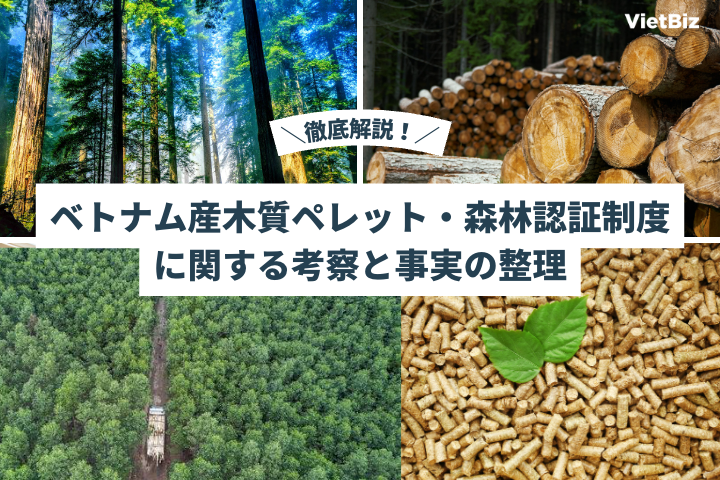Introduction:Vietnam’s Forestry Industry and Vietnam’s Wood Pellet Industry
With the development of biomass power generation in Japan, Japan’s imports of wood pellets from Vietnam have been growing since around 2018; in 2022, Japan’s imports of wood pellets from Vietnam amounted to about 2.18 million tons, accounting for about 53.5% of Japan’s total imports. They are now an indispensable component of Japan’s renewable energy.
Vietnam’s major industries are forestry and wood and wood products, and there is a large amount of raw material for wood pellets. It would be very useful to support renewable energy in Japan and other countries by using wood raw materials, which have not been effectively utilized in the past, as fuel.
The most important point is that the Vietnamese government has long been actively promoting sustainable forest development. FSC certification has been actively pursued since 2007. The Vietnamese government has also established its own domestic forest certification system, is a member of the World Wide Fund for Nature (WWF), and has implemented a variety of environmental protection policies.
Therefore, in this article, we would like to explain Vietnam’s forestry and wood pellet industry based on objective data, facts, and evidence, including basic information on Vietnam’s forestry industry, the structure of Vietnam’s forest certification system, and export trends of wood pellets produced in Vietnam.
This media outlet has been providing Japanese companies with the latest trends and future forecasts for business in Vietnam. In this theme, we would like to objectively organize Vietnam’s forest certification and wood pellet industry, which has become a hot topic (*) in the wake of AVP, the largest wood pellet supplier in Asia, as a series of four thematic articles as follows.
*October 2010, FSC announces that it will investigate possible quantity discrepancies in wood pellets sold by AVP.
【Article topics to be handled by Betobiz in the future】
- Part 1 (this article): Overview of forest certification and general situation of forestry in Vietnam
- Part 2: Consideration of the Vietnamese government’s sustainable forest development policy and wood pellet certification system.
- Part 3: Trend of wood pellet export industry and forest certification by Vietnam.
- Part 4: Explanation of important points for Japanese companies to enter the wood industry in Vietnam and how to monitor Vietnamese companies.
The first article will provide an overview of the forestry industry in Vietnam, as well as basic information on forest certification, including its overview, structure, and status of acquisition.
Overview of Forestry in Vietnam
Vietnam has a well-developed forestry industry compared to the rest of the world. Currently, Vietnam exports timber and wood products to all over the world, including Japan. 2022, Vietnam ranks 7th in the world in the production of wood products. In 2022, Vietnam will rank 7th in the world in the production of wood products, 2nd in the Asia-Pacific region, and 5th in the world in the export of wood products. The recent development of Vietnam’s wood products and timber industry is due to the country’s inherently abundant forest resources.
Forest Area
According to the General Department of Statistics of Vietnam, Vietnam will own 14.76 Mil ha of forest by 2021, accounting for 0.36% of the world’s total forest area. Vietnam’s forest area has been increasing year by year, with about 5% more forest area than in 2015. As of 2022, the area of natural forests will reach 10.17 Mil ha, accounting for 69% of the national forest area.
On the other hand, planted forests account for about 30%, reaching 4.57 Mil ha in 2022. The area of planted forests is trending to increase annually, increasing at an average annual growth rate of 2.75% in the 2015-2021 period. It is projected to continue increasing in the future. This is due to the Vietnamese government’s plan for sustainable afforestation, and since the timber industry is a key industry, afforestation and logging are being carried out systematically.
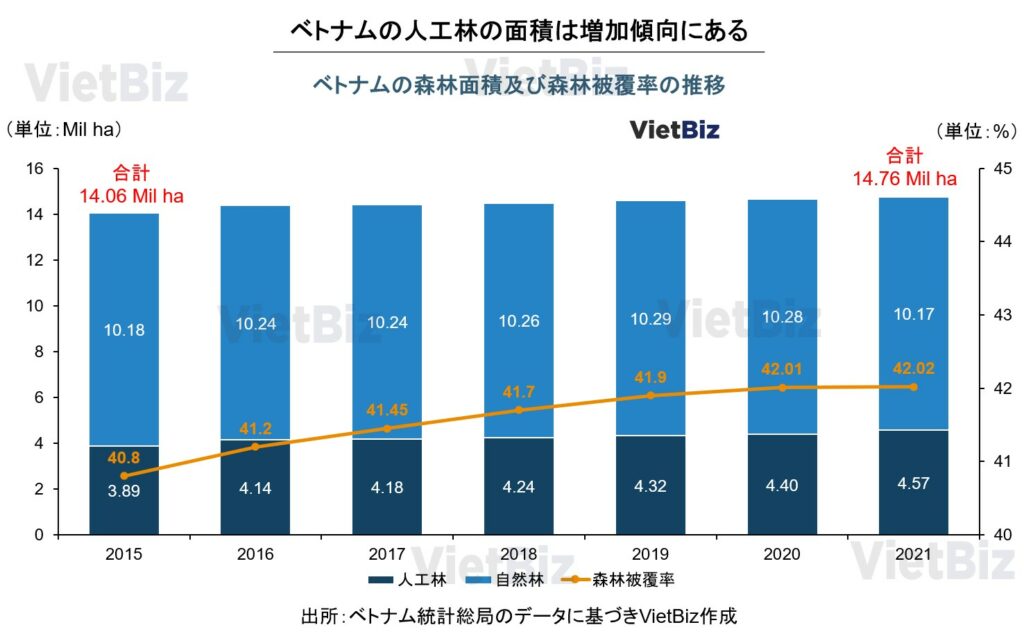
In addition, forest cover in Vietnam is higher than the average forest cover in the world (31%). With the increase in forest area, forest cover in Vietnam has been increasing year by year: from 40.8% in 2015 to 42.02% in 2021.
By region, the North Central and Central Coastal regions have the highest forest cover, reaching 54.19%. This is followed by the northern inland and mountainous regions (53.84%) and the plateau region (46.33%).
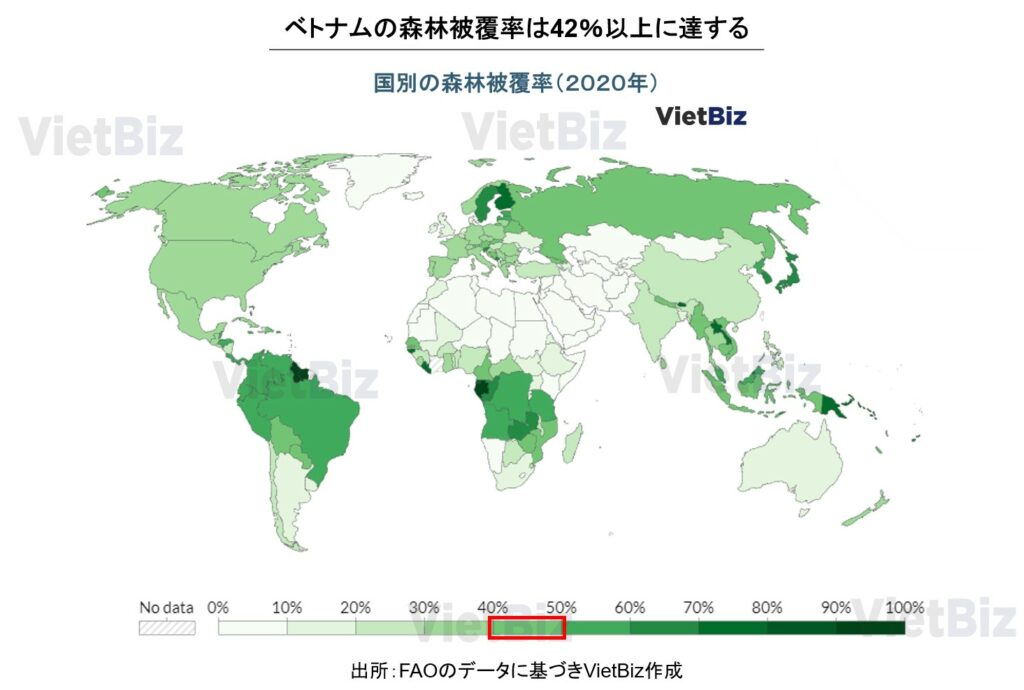
Distribution of Forests in Vietnam
Vietnam has forests in 60 provinces throughout the country, mainly concentrated in the northern inland and mountainous areas and the north-central and central coastal areas. The forests are mainly concentrated in the northern inland and mountainous areas and the north central and central coastal areas, and in 2021, the forest area in the north central and central coastal areas will be 5,582.7 thousand ha, accounting for 38% of the national forest area.
This is followed by the northern inland and mountainous regions with 5,375 thousand ha of forest area, accounting for 36% of the total forest area. Among the 60 provinces with forests, Nghe An Province is the province with the largest forest area with 1,008.8 thousand ha, accounting for 6.8% of the total forest area nationwide. The total forest area owned by the 10 provinces with the largest forest ownership in Vietnam accounts for about 44% of the total forest area in Vietnam.
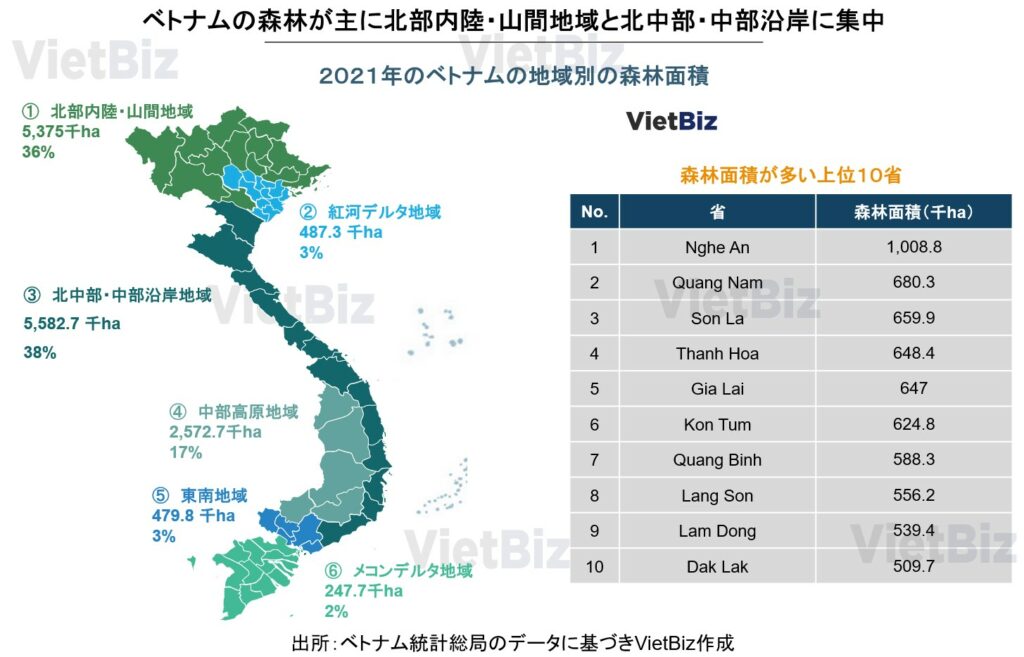
Amount of Forest Resources in Vietnam
According to data from the Vietnam National Forestry Master Plan, Vietnam’s forest wood accumulation in 2020 increased by 15% compared to 2017. Of this, wood accumulation from natural forests will account for 84%, and wood from population forests will account for 16%.
| Forest wood accumulation (m3) | planted forest | natural forest | total |
| 2017 | 190,017,060 | 992,801,935 | 1,182,818,995 |
| 2020 | 222,631,882 (↑17%) | 1,138,255,800 (↑15%) | 1,360,887,683 (↑15%) |
Vietnam’s forest accumulation by region in 2020 is shown in the table below.
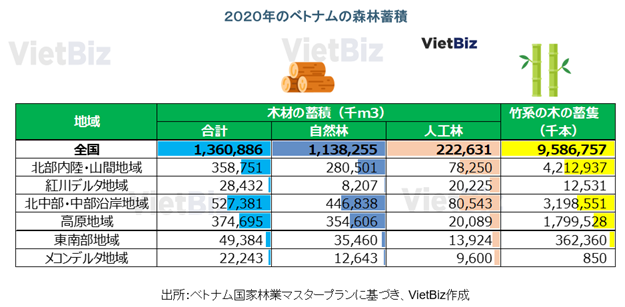
By region, the North Central and Central Coast region will account for 39% of Vietnam’s forest timber stock in 2020, amounting to 527,381,000 ha. This is followed by the highland areas (27%, 374,695,000 ha) and the northern inland and mountainous areas (26%, 358,751,000 ha). Regarding the accumulation of bamboo trees, the accumulation in the northern inland and mountainous areas (4,212,937 thousand trees) is ranked first, accounting for 44% of the national total.
In second place is the North Central and Central Coast region, with 3,198,551,000 trees, or 33% of the national total. In short, more than 90% of Vietnam’s forest accumulation is concentrated in the northern inland and mountainous regions, the north-central and central coastal regions, and the plateau region.
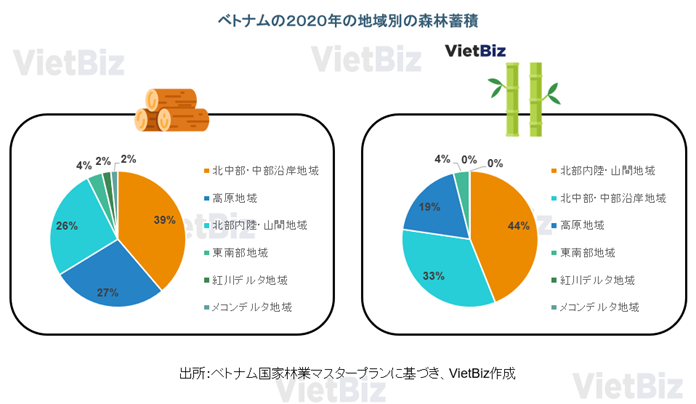
With the expansion of forest area and forest accumulation, the amount of deforestation in Vietnam is also increasing. Deforestation volume has grown from 11.4 Mil m3 in 2015 to 18.38 Mil m3 in 2021. in the period 2015-2021, the average annual growth rate of deforestation volume is 8.3%/year. in 2020, forest wood harvesting volume is about 1.26% of Vietnam’s forest wood accumulation. The average annual growth rate of forest logging is 8.3%/year in the period 2021-2021.
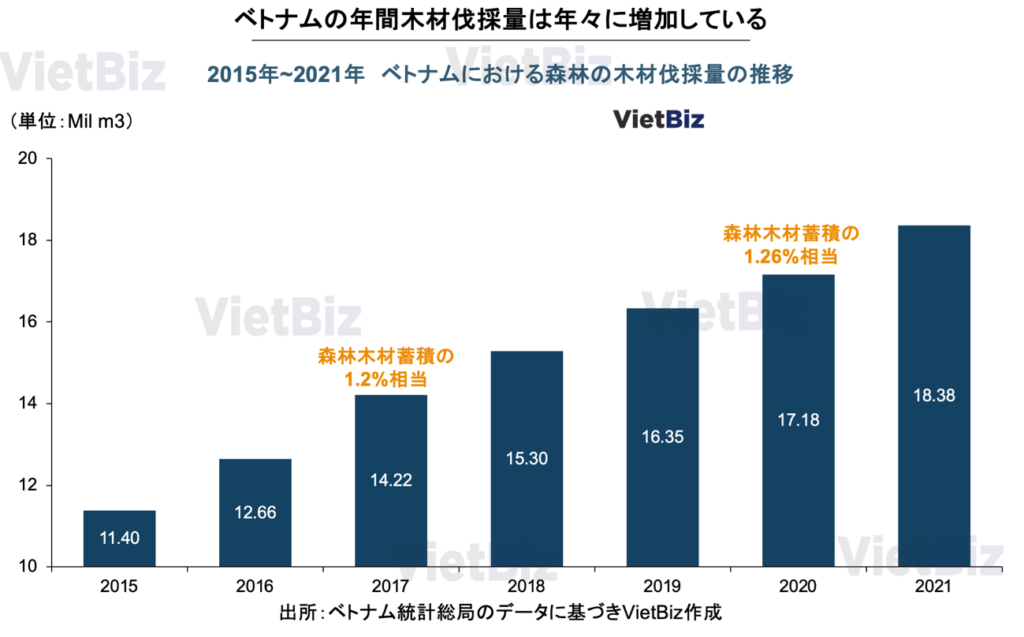
By region, forest harvesting is currently concentrated mainly in the north-central and central coastal areas, which account for about 59% (about 10,854.8 thousand m3) of the nation’s total logging volume, followed by the northern inland and mountainous areas, which account for about 26% (about 4,847.9 thousand m3) of the nation’s total logging volume. The total logging volume of the top 10 provinces with the highest logging volume accounts for 62% of the nation’s total logging volume, and the specific logging volumes are shown in the table below.

Forest Tree Species in Vietnam
For natural forests in Vietnam, they can be divided into the following four types by tree species. Among them, tree forests are the main forest land type.
- Tree forests: area is 8.9Mil ha, natural forest surface accounts for 86.54% (2020)
- Mixed forests of tree and bamboo: 1.14Mil ha in area, 11.10% of which is natural forest (2020)
- Bamboo forests: 0.24Mil ha in area, 2.32% of natural forest area (2020)
- Bamboo forests: 4,358 ha in area, 0.04% of natural forest area (2020)
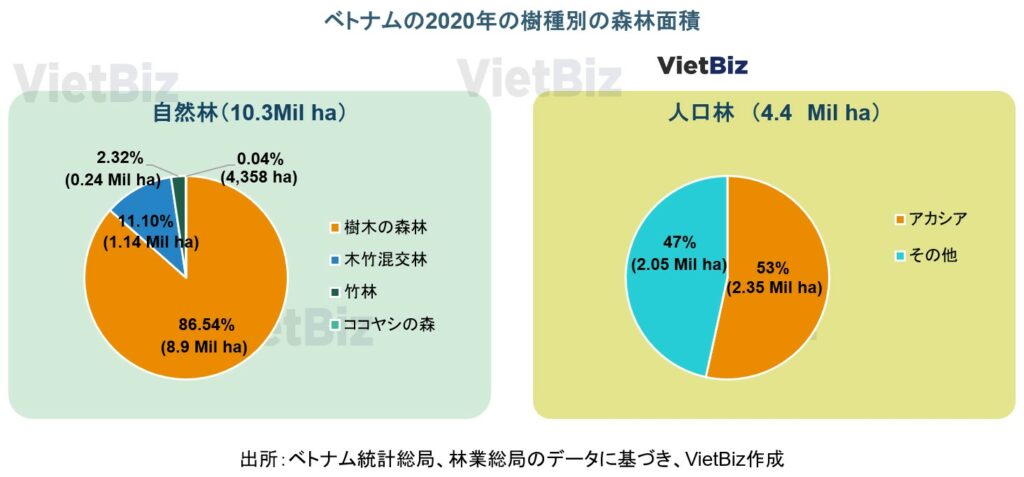
In terms of tree species in planted forests, Acacia forests are the main species. According to the Directorate General of Forestry, the area of Acacia forests in 2020 will reach 2.35Mil ha, equivalent to 53% of the total area of planted forests. The remaining area (47% or 2.05Mil ha) will be planted with more than 50 species of trees, including rubber and eucalyptus. In other words, Acacia is the most important timber in the Vietnamese timber and wood products industry.
Types and Overview of Forest Certification Systems in Vietnam
In recent years, each forest certification has been actively promoted in many countries or in a regional or global scope for forest protection and sustainable development. As one of the world’s leading exporters of timber and wood products, Vietnam has introduced three forest certification systems to meet the demand of foreign export markets for forest certified products and timber, and to ensure compliance with sustainable development for its forests. Among them,
- FSC and PEFC are international forest certifications.
- PEFC is the world’s largest international forest certification.
- VFCS is Vietnam’s national forest certification system issued under its own set of rules and standards, which was officially recognized by PEFC effective October 29, 2020, so that from 2020, forest areas certified as VFCS certified will simultaneously be PEFC certified.
An overview of the above three forest certifications is summarized below.
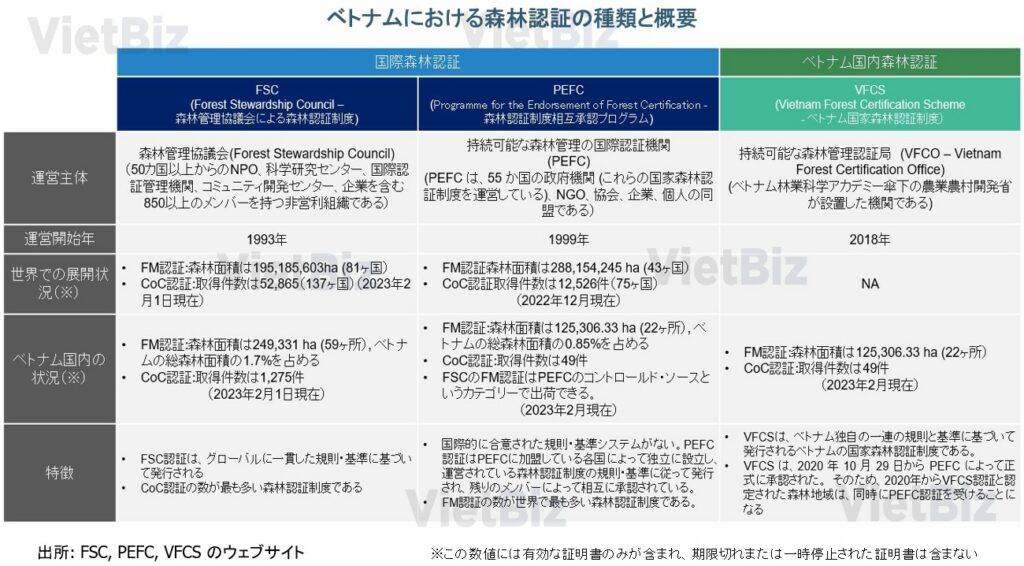
Each of the forest certification systems has two types of certification, Forest Management (FM) and Chain of Custody (CoC), and the targets and scope of FM and CoC certification are specifically described below.
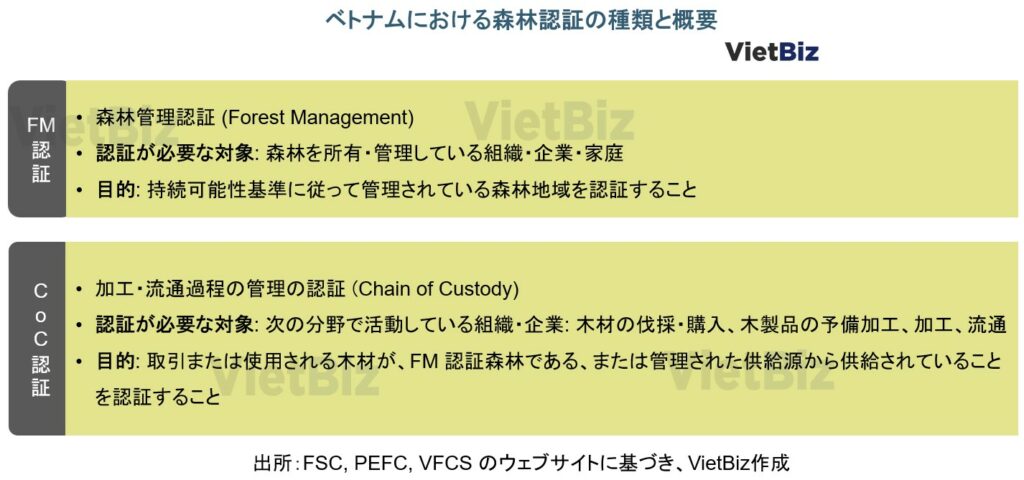
Certified Forest Lands in Vietnam
As of February 2023, 374,637 ha of Vietnam’s forests (representing 2.55% of Vietnam’s total forest area) have been granted certification for sustainable forest management. It is estimated that about 4.5 million tones of products can be produced annually as certified wood(*). *Managed wood is excluded.
FSC-FM Certified Forest Land
- In 2007, Vietnam’s first 9,904 hectares of forest were granted FSC-FM certification. Since then, the area of forests with FSC-FM certification has increased rapidly since 2012; as of February 1, 2023, the area of forests with FSC-FM certification is 249,331 ha (59 sites), accounting for 1.7% of Vietnam’s total forest area.
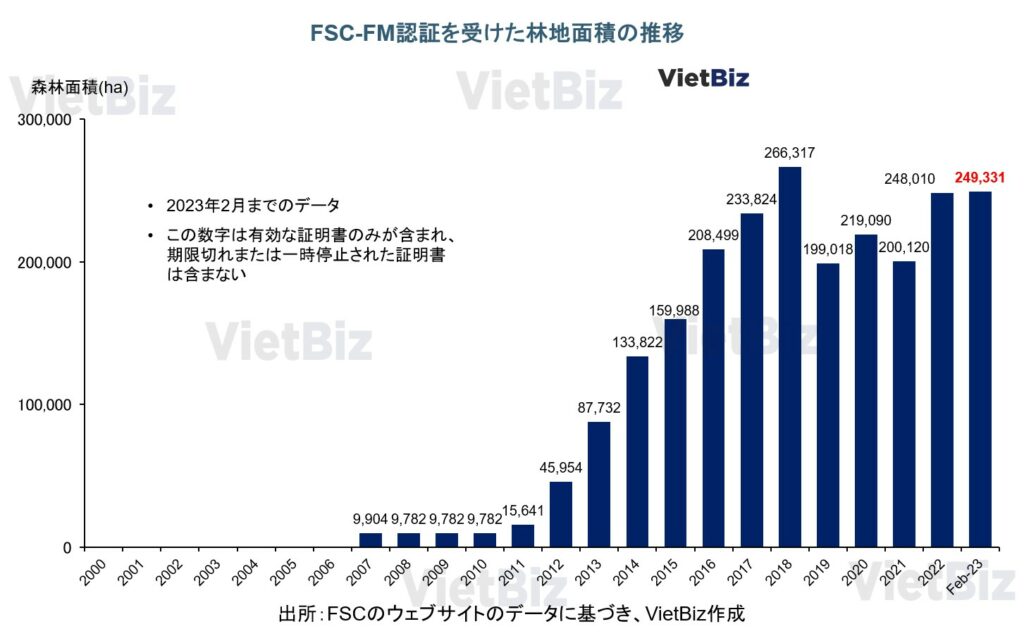
- Most of the forests with FSC-FM certification are planted forests. The rest are a few natural forests.
- There are two main groups that hold FSC-FM certification
- Group 1: Enterprises (including state-owned, private, and foreign-owned enterprises). This is the group that owns more certified forests.
- (2) Group 2: Households. These households either work with each other or with the Forest Protection Agency/Farmers Association and local wood processing enterprises.
- Distribution of FSC-FM certified forests: FSC-FM certified forests are located in 24/63 provinces; more than 90% of FSC-FM certified forest area is concentrated in the North Central region; the top 10 provinces with the largest FSC-FM certified forest area total 189,751.36 ha or 76% of FSC-FM certified forest area. The top 10 provinces with the largest forest area with FSC-FM certification total 189,751.36 ha, or 76% of the FSC-FM certified forests.
- Most of the forests with FSC-FM certification are planted forests. The rest are a few natural forests.
- There are two main groups that hold FSC-FM certification
- Group 1: Enterprises (including state-owned, private, and foreign-owned enterprises). This is the group that owns more certified forests.
- (2) Group 2: Households. These households either cooperate with each other or with the Forest Protection Agency/Farmers’ Association and local wood processing enterprises.
- Distribution of FSC-FM certified forests: FSC-FM certified forests are located in 24/63 provinces; more than 90% of FSC-FM certified forest area is concentrated in the North Central region; the top 10 provinces with the largest FSC-FM certified forest area total 189,751.36 ha or 76% of FSC-FM certified forest area. The top 10 provinces with the largest forest area with FSC-FM certification total 189,751.36 ha, or 76% of the FSC-FM certified forests.
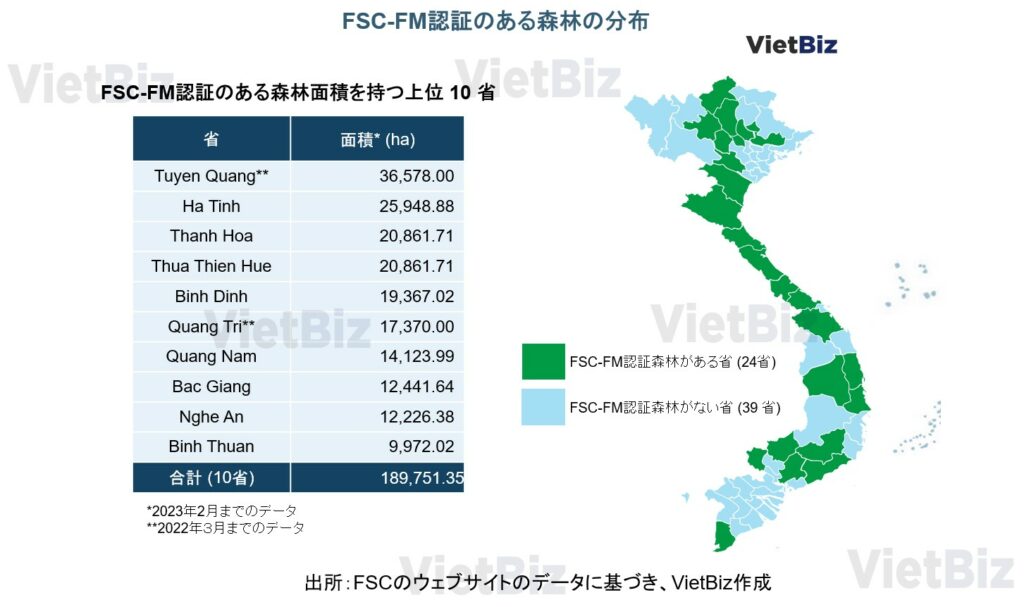
PEFC-FM Certified Forest Land
- In 2021, Vietnam’s first 46,657 hectares of forest were PEFC-FM certified. As of February 2023, Vietnam has 125,306.33 hectares of forest (22 sites) certified under PEFC-FM.
- Of this, 112,224.98 hectares are planted rubber forests (accounting for 90%) and the remaining 13,081.35 hectares are populated forests of other trees (accounting for 10%).
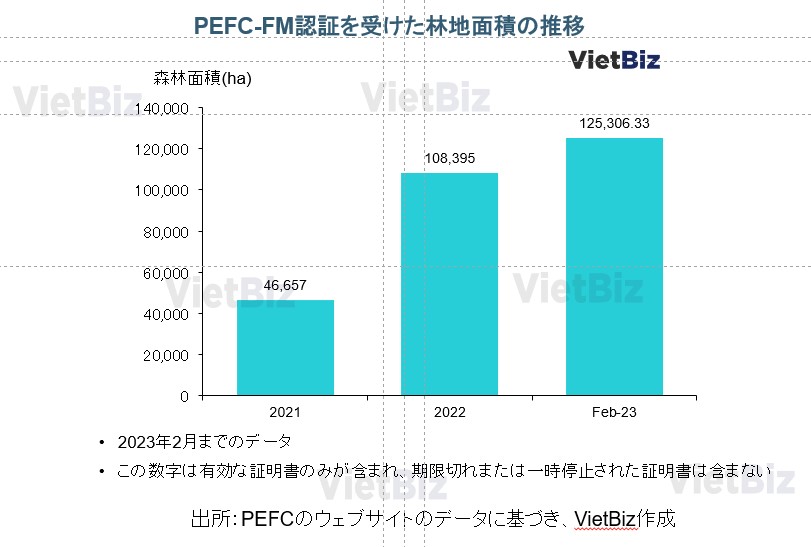
- 100% of certified forest area is planted forest
- There are two main groups that own PEFC-FM certification.
- Group 1: Vietnam Rubber Industry Group (VRG). The company owns 112,224.98 hectares of populated rubber forests, accounting for 90% of Vietnam’s PEFC-FM forest area.
- Group 2: Private companies and forestry cooperatives. Own the remaining 10% certified forest, which is a population forest of other trees except rubber
- Distribution of PEFC-FM certified forests: 90% of PEFC-FM certified forest area is concentrated in the Central Highlands and Southeast; PEFC-FM certified forests are located in 13/63 provinces; the province with the largest area of PEFC-FM certified forests is Binh Phuoc province with 46,413.91 ha or 37% of PEFC-FM certified forests. This area accounts for 37% of the forests with PEFC-FM certification.
- FSC FM certification can be shipped under the category of PEFC controlled source.
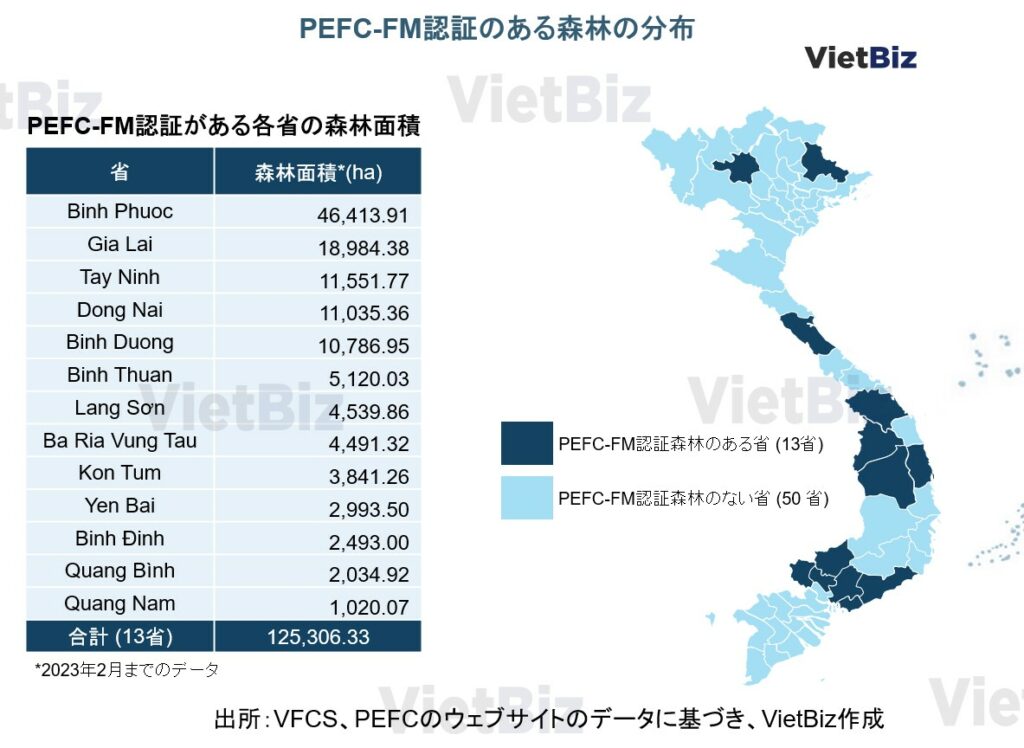
How the FSC Certification System Works
Next, I would like to describe the mechanism of the FSC certification system.
How FSC Certification Works
The FSC certification system is based on globally consistent rules and standards, and is completely independently verified and certified by international certification bodies that are not directly affiliated with Vietnamese government agencies. The certification accreditation is carried out as shown in the figure below.
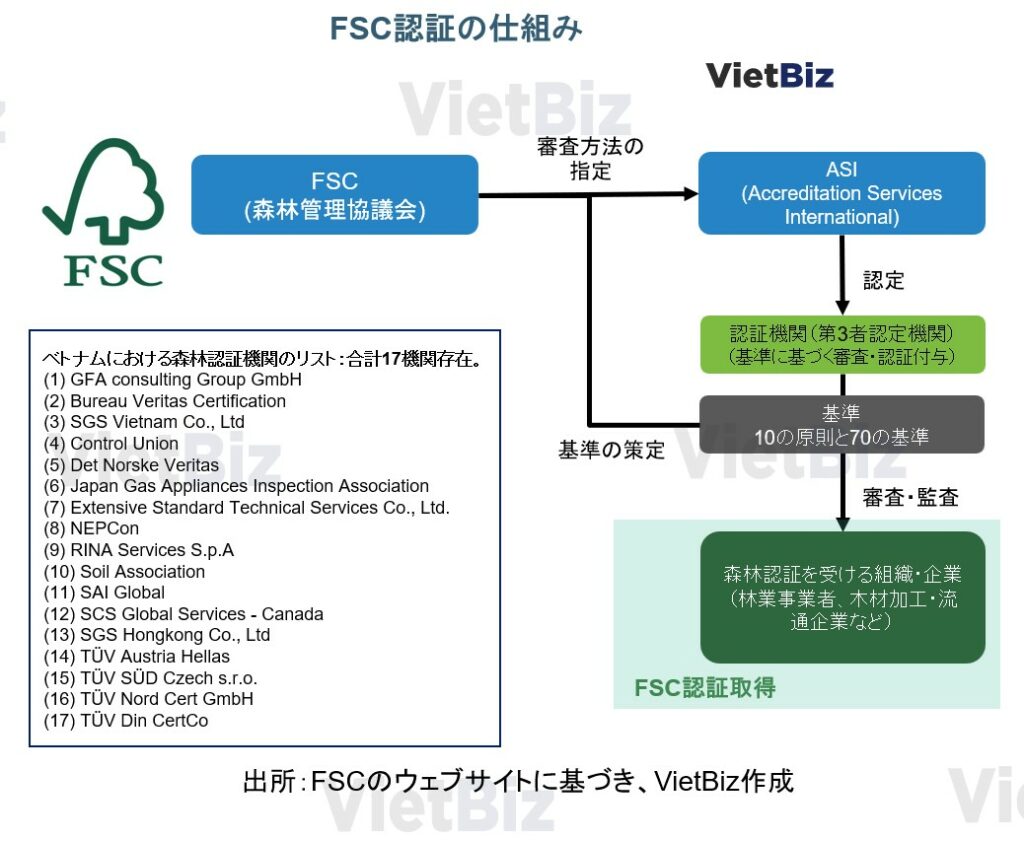
- ASI is the accreditation and oversight body for certification bodies
- Certification Body: Audits based on certification standards are conducted by independent third-party certification bodies accredited by FSC’s organization, Accreditation Services International (ASI).
- Periodic audits: In addition to initial criteria audits, annual audits and renewal audits are conducted every year and every five years to ensure regular auditing and maintenance. The separation of FSC, which is responsible for system operation and standards development, and the certification body, which conducts audits and audits, has earned it a reputation as a fair and highly reliable system. Certification bodies investigate and inspect certified organizations and companies, and if an external inspection is requested, they can suspend the validity of the certification and terminate it depending on the results of the verification. Currently, there are 17 certification bodies in Vietnam.
Flow of FSC-FM Certification Accreditation
Companies, organizations, and groups of individual forestry households that own or manage forests and wish to obtain FSC-FM certification must meet the FSC criteria system, which includes 10 principles and 70 criteria. The following is a description of the 10 principles.
- Compliance with Laws: Observe national laws and international conventions related to forest management and trade
- Labor rights and working environment: protect workers’ rights and safety
- Indigenous Peoples’ Rights: do not violate the rights of indigenous peoples
- Community Relations: work with and build good relationships with local communities
- Benefits of forests: consider the multifaceted functions of forests
- Environmental Values and Impacts: assess environmental impacts and protect the environment
- Management planning: planning based on accurate data and information
- Monitoring and evaluation: environmental and social impacts are monitored and negative impacts are minimized.
- High conservation values: High ecological and social conservation values of the forest are to be protected.
- Implementation of management activities: Management activities should be carried out as planned.
In Vietnam, FSC-FM is approved according to the “Vietnam National FSC Forest Management Standard”, FSC-STD-VN-01-2018, which is based on the above 10 common international rules (including 70 criteria) and slightly adjusted to suit the characteristics of Vietnam. The detailed contents of 2018 (English version) can be found in thisリンクで確認できる。FSC-FM認証の認定流れは基本的に次のステップを含める。

Flow of FSC-CoC Certification
Companies in Vietnam that wish to obtain FSC-CoC certification will fulfill the common international FSC standard system (regulation symbol: FSC-STD-40-004 V3-1), which includes 7 principles. The 7 principles are as follows.
- CoC Management System: Companies shall operate and maintain a CoC management system appropriate to the size and complexity of the organization.
- Raw material sourcing: companies shall maintain up-to-date information on all suppliers of raw materials used in FSC product groups.
- Raw material handling: Where there is a risk of ineligible raw materials entering the FSC product group, companies shall implement appropriate segregation procedures.
- FSC raw material and product records: Companies must identify, by product group or by order, the main processing steps that change the volume or weight of raw materials, and identify the conversion rate for each step or, if this is not possible, for the entire processing step
- Marketing: Organizations must ensure the reliability of information contained in marketing documents issued for products sold with the FSC label.
- Compliance with wood legality laws and regulations: Companies must ensure that their FSC certified and controlled wood products or wood products meet all applicable wood legality laws and regulations
- FSC Core Labor Requirements: In applying FSC’s Core Labor Requirements, companies must take full account of the rights and obligations established by national laws and regulations, while at the same time meeting the objectives of these Requirements.
Above are the seven basic rules of the FSC-CoC. The detailed contents and criteria (Japanese version) included in the rules are in thisリンクで確認できる。The accreditation flow for FSC-CoC certification is the same as the accreditation flow for FSC-FM certification, from preparation for the main audit to the renewal audit. The main audit also includes a document audit and an on-site audit. Among them,
- On-site assessment: Confirmation that approved wood is not mixed with non-conforming wood.
- Document review: Training of employees on FSC-CoC, review of documents related to management of raw materials and products.

Summary
In summary, Vietnam is a country with abundant forestry resources by nature, and is one of the countries with a thriving forestry industry. The Vietnamese government, which positions forestry as a key industry, has been implementing afforestation and logging based on a sustainable forest development plan. The Vietnamese government has also established its own domestic forest certification system, joined the World Wide Fund for Nature (WWF), and implemented various environmental protection policies. In fact, Vietnam’s forest land area, forest cover, and saved resources are on the increase, and the amount of forest timber harvested in 2020 is only equivalent to about 1.26% of Vietnam’s forest timber stock.
Currently, there are three major forest certification schemes in Vietnam: FSC, PEFC, and VFCS. the FSC certification scheme is completely independently verified and certified by an international certification body that is not directly affiliated with any Vietnamese government agency, while the VFCS/PEFC certification scheme is managed by VFCO which belongs to the Ministry of Agriculture and Rural Development of Vietnam. The principle is to operate in accordance with Vietnam’s national sustainable forest development policy.
From the above, you can see that Vietnam is rich in forestry resources and has a development plan based on a certification system. Based on this basic data on Vietnam’s forestry industry, this media outlet will continue to examine export trends in Vietnam’s wood pellet industry using objective data and statistics in the next and subsequent issues. Vietnam Market Research Report List
ベトナム市場調査レポート一覧はこちらからもご覧頂けます。

ベトナム市場の情報収集を支援します
ベトナム市場での情報収集にお困りの方は多くいらっしゃるのではないでしょうか。
VietBizは日本企業の海外事業・ベトナム事業担当者向けに市場調査、現地パートナー探索、ビジネスマッチング、販路開拓、M&A・合弁支援サービスを提供しています。
ベトナム特化の経営コンサルティング会社、ONE-VALUE株式会社はベトナム事業に関するご相談を随時無料でこちらから受け付けております。
